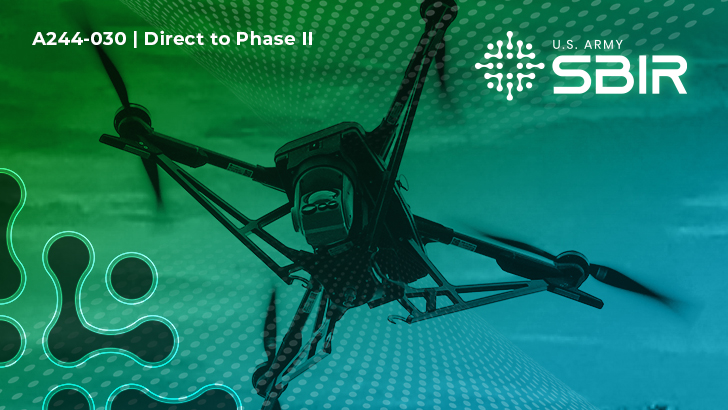

Selectees
Objective
The Army seeks to develop a sensor prototype to meet the necessary Size, Weight and Power requirements for integration into various ongoing modernization programs. The technology should be an internally-calibrated, compact, passive, day/night capable hyperspectral sensor that will drive cost savings and substantial reductions in weight, power and volume without sacrificing capability. This sensor payload will integrate with smaller Unmanned Aerial Systems.
Description
Airborne hyperspectral imaging systems have historically required heavy and complex optical components, high power consumption and large ancillary hardware to facilitate cooling, calibration, data collection and data processing. These factors limit the number of potential operating platforms capable of managing such payloads for larger aircrafts, resulting in limited accessibility and availability.
Phase I
The Army will only accept Direct to Phase II proposals for potential contracts worth up to $2 million for a 24-month performance period. Vendors interested in submitting a DP2 proposal must provide documentation showing the technology’s scientific, technical merit and feasibility are equivalent to a Phase I project. The documentation can include data, reports, specific measurements and the success criteria of a prototype.
Phase II
Phase III
Vendors must integrate the sensor/gimbal payload into a prototype system for field collection. Vendors should also deploy the sensor on at least one test event to observe its performance and generate quantitative/qualitative sensor performance data.
Submission Information
All eligible businesses must submit proposals by noon, ET.
To view the full solicitation details, click here.
For more information, and to submit your full proposal package, visit the DSIP Portal.
Applied SBIR Help Desk: usarmy.pentagon.hqda-asa-alt.mbx.army-applied-sbir-program@army.mil

References:
U. G. Sankararao, N. T. S. Kumar and P. Rajalakshmi, “Workflow and Calibration of Airborne Hyperspectral Imaging System,” 2020 IEEE International Conference on Computing, Power and Communication Technologies (GUCON), Greater Noida, India, 2020, pp. 757-762, doi: 10.1109/GUCON48875.2020.9231236. URL: https://ieeexplore.ieee.org/document/9231236
Y. Zhong et al., “Mini-UAV-Borne Hyperspectral Remote Sensing: From Observation and Processing to Applications,” in IEEE Geoscience and Remote Sensing Magazine, vol. 6, no. 4, pp. 46-62, Dec. 2018, doi: 10.1109/MGRS.2018.2867592. URL: https://ieeexplore.ieee.org/document/8573977
Hyperspectral, VNIR, SWIR, LWIR
Selectees
Objective
The Army seeks to develop a sensor prototype to meet the necessary Size, Weight and Power requirements for integration into various ongoing modernization programs. The technology should be an internally-calibrated, compact, passive, day/night capable hyperspectral sensor that will drive cost savings and substantial reductions in weight, power and volume without sacrificing capability. This sensor payload will integrate with smaller Unmanned Aerial Systems.
Description
Airborne hyperspectral imaging systems have historically required heavy and complex optical components, high power consumption and large ancillary hardware to facilitate cooling, calibration, data collection and data processing. These factors limit the number of potential operating platforms capable of managing such payloads for larger aircrafts, resulting in limited accessibility and availability.
Phase I
The Army will only accept Direct to Phase II proposals for potential contracts worth up to $2 million for a 24-month performance period. Vendors interested in submitting a DP2 proposal must provide documentation showing the technology’s scientific, technical merit and feasibility are equivalent to a Phase I project. The documentation can include data, reports, specific measurements and the success criteria of a prototype.
Phase II
Phase III
Vendors must integrate the sensor/gimbal payload into a prototype system for field collection. Vendors should also deploy the sensor on at least one test event to observe its performance and generate quantitative/qualitative sensor performance data.
Submission Information
All eligible businesses must submit proposals by noon, ET.
To view the full solicitation details, click here.
For more information, and to submit your full proposal package, visit the DSIP Portal.
Applied SBIR Help Desk: usarmy.pentagon.hqda-asa-alt.mbx.army-applied-sbir-program@army.mil
References:
U. G. Sankararao, N. T. S. Kumar and P. Rajalakshmi, “Workflow and Calibration of Airborne Hyperspectral Imaging System,” 2020 IEEE International Conference on Computing, Power and Communication Technologies (GUCON), Greater Noida, India, 2020, pp. 757-762, doi: 10.1109/GUCON48875.2020.9231236. URL: https://ieeexplore.ieee.org/document/9231236
Y. Zhong et al., “Mini-UAV-Borne Hyperspectral Remote Sensing: From Observation and Processing to Applications,” in IEEE Geoscience and Remote Sensing Magazine, vol. 6, no. 4, pp. 46-62, Dec. 2018, doi: 10.1109/MGRS.2018.2867592. URL: https://ieeexplore.ieee.org/document/8573977
Hyperspectral, VNIR, SWIR, LWIR
